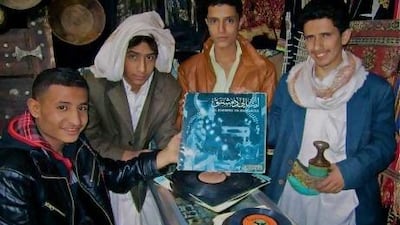In markets and antique shops across Yemen's capital city of Sanaa, a vast vinyl heritage has been gathering dust in cardboard boxes for the past 50 years.
Songs by a generation of Yemeni singers, with lyrics about unrequited love and inner turmoil, were impressed on to records after a rush of ad hoc recordings and studio sessions across the country throughout the 1960s.
Chris Menist is an avid collector and rescuer of old records, and spent two months in 2011 scouring markets in Sanaa and Aden for any bit of vintage vinyl he could lay his hands on. This search has culminated in Qat, Coffee and Qambus: Raw 45s from Yemen, a compilation of reissued tracks from among his best finds, released last month on the Dust-To-Digital record label.
"The Yemeni music I was finding reminded me of early blues recordings," says Menist, who was in the country just weeks before the start of protests against the leadership of Ali Abdullah Saleh.
"There was an honesty and rawness about the sound, like somebody just switched on a recorder and the musicians played without interference from record label people in the background. I don't understand the lyrics, but there's a great amount of emotion and, in a positive sense, simplicity to the music."
Menist holds a day job as a consultant for NGOs and the United Nations, but couples this with regular research trips to find and unearth overlooked music from around the world. He's previously worked on compilations of psychedelic rock from 1960s and 1970s Thailand.
The eight tracks on this new Yemen release sport enigmatic titles such as Hey, Who Enters the Sea of Passion? and Night Stars Watcher, and have a remarkably different sound from what is typically associated with Arabic music from that era. These singers, though active as recently as the 1960s, seem to call out from a more ancient period.
"There's a strong, poetic tradition in Yemeni culture, and a lot of these songs were recited during social gatherings or when people were chewing qat," says Menist, referring to the plant that, when chewed, has a narcotic stimulant effect and is an overarching pastime among many Yemenis.
"This is one of the oldest inhabited places on Earth," says Menist. "Culturally it's so rich, but has been left behind economically in places touched by the oil boom like Saudi and the UAE. In a positive sense, that has meant it's retained its originality." Conversely, he notes, this has also left much of the country mired in poverty.
Menist hears a rhythmic element in the music much stronger than that found in traditional centres of Arab music production such as Baghdad and Cairo. This may be the result of Yemen's proximity to the East African coast, he suggests, and there are audible connections between the music's jangling, bouncing cadence and that found in Swahili island settlements such as Zanzibar and Lamu.
But the compilation also captures the final years of popularity for the qambus, a fur-lined, lute-like instrument indigenous to Yemen that was superseded in popularity with the more widespread accessibility of the oud from the 1970s.
Menist market-crawled for two months, working closely with a de facto local fixer called Selim, and carting around his portable record player. "Most of the people I met there hadn't heard this music for 30 years, simply because they don't have the means to play records. Vinyl is regarded as an outmoded medium, and particularly in the Middle East."
HMV set up a recording studio in Aden in the 1950s, and the recordings produced at this time, Menist believes, remain locked away in the record label's vast archive in Middlesex, England. The field of studies for Yemeni popular music is fairly new, and when Menist returned to the UK with a stack of records, he was struck by the lack of academic writings on the subject.
"I feel like I've only just scratched the surface, and wouldn't say this record is a comprehensive overview. But it is a snapshot of a certain era."
Dust-To-Digital is part of a growing number of record labels that specialises in unearthing and reissuing old records from less widely known music hubs. Analog Africa, Soundway Records and Strut are just a few of these start-ups bringing vibrant vintage sounds from West Africa, South America and South-East Asia to a wider audience. With a backdrop of independence from colonial European powers, the 1960s and 1970s also saw a collision of local music with western styles in these regions as funk, soul and psychedelia created interesting crossovers and fusion.
Aside from ensuring documentation of this time, these labels are catering to a growing number of DJs looking to diversify their funk and soul sets with sounds from off the beaten track.
But the broader Middle East has yet to find a focus in this reissuing frenzy. There have been previous compilations of lesser-known sounds from the region before (see sidebar) but junk shops, home collections and flea markets in Cairo, Baghdad, Beirut and Algiers are still untapped troves for forgotten records of the past 100 years.
Menist says it's only a matter of time before this hunger will start to penetrate more into the region.
"And if reissues kick-start interest in the country itself, that would be the great conclusion," he says. "A lot of this old music has ideas and artistic strengths that a younger generation hasn't yet been able to appreciate."
Qat, Coffee and Qambus: Raw 45s from Yemen is available from dust-digital.com
Follow
Arts & Life on Twitter
to keep up with all the latest news and events

